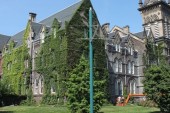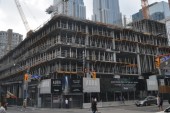
This week Toronto hosted the annual green building festival—the first time the US Green Building Council-run event was held outside the United States. The Toronto Standard popped in to see what’s new in the business of changing the world.
1. Jane Fonda started the green movement. In his opening keynote address, New York Times columnist Thomas Friedman cited the 1979 movie The China Syndrome as one of the key moments in green building history. A physicist in the movie says a nuclear meltdown would “render an area the size of Pennsylvania permanently uninhabitable.” Twelve days after the film’s release, a near-disastrous core meltdown actually took place at the Three Mile Island Nuclear Generating Station near Harrisburg, Pennsylvania (Friedman went on to point out that since then not a single new nuclear power plant has been approved in the US).
2. All the wasted food from a restaurant can be composted in 24 hours. The folks at the Orca Green Food Digester booth showed me how their giant-sized composter can break down up to 2,000 pounds of food in a 24-hour period using natural microorganisms (that come in teeny pellets), which means none of the odour and bug problems often associated with larger-scale composting.
3. Homes can flat pack. Prefabs—houses that are built in a factory setting and then shipped to the building site in modules—are often green by default, as they reduce the impact on the environment and decrease building waste. But exhibitor Blu Homes made even the shipping part more sustainable by offering a range of modern prefabricated homes that fold up like a cardboard box for transit. Once on-site, the building is unfolded (with everything, including appliances, already installed) and is ready for move-in within a day or two.
4. Concrete buildings can clean the air. Exhibitors like Essroc and Tiochem were showing photocatalytic cement products that clean themselves and the air around them, thanks to a binder that uses sunlight to break down pollutants like smog, tobacco smoke and carbon monoxide.
5. Designer electric car chargers are hitting the market for real. There were lots of chargers at the show but I can’t get enough of Yves Behar‘s colourful, curvaceous WattStation for GE, who recently announced a partnership with Lowes to sell their chargers, and more partnerships are on the way.
6. The first electric air conditioner was invented 109 years ago by Willis Carrier, founder of the HVAC company (and the first company to join the US Green Building Council). During one of the conference presentations, USGBC founding chair Rick Fedrizzi had a nice quote from Carrier: “we should always strive to obsolete our greatest triumph.”
7. Green building is recession-proof. In the same presentation, Carrier president Geraud Darnis reported that in 2005, only two per cent of the US commercial construction market was green. By 2008 it was 12 per cent. By 2010 that number was up to 35 per cent. “”Think of the possibilities and how this movement will accelerate when the economies to come back,” said Darnis.
8. Anyone with an electrical outlet and a computer can monitor their energy use. I’ve seen plenty of energy monitoring systems but Modlet by ThinkEco is by far the simplest I’ve seen. Plug the outlet extension over an existing outlet, plug a wireless USB drive into the computer, and use the device to see what electrical devices are sucking energy. You can also use the product to program shut off on a timer or automatically when its not being used.
9. Developing countries can go green. Project Haiti, a new partnership between the USGBC and architecture firm HOK, is aiming to build a LEED Platinum orphanage in Port-au-Prince, Haiti. “If we can build a LEED Platinum building here in the poorest country in the western hemisphere,” said USGBC chief of staff Roger Limoges in a video presentation on the project’s progress, “we can build one anywhere.”
10. 1,000 years from now we’ll be making a chaise longue from your baby’s DNA. At least, that’s the hope of architect and MIT Media Lab professor Neri Oxman, who spoke on the future of material-based design. “Of course there are lots of issues,” she quickly added, “but what if material could actually think?”
__
Paige Magarrey is a regular writer on design for Toronto Standard.

















